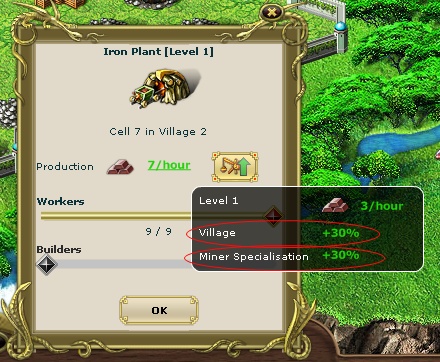Wood is produced in:
Crops are produced in:
Stone is produced in:
Gold is produced in:
Iron is produced in:
The
Black Gem is a special resource. A separate
article is dedicated to it.
Resources Production rate can be affected by:
- 1. Race features. Race Bonus is considered in initial characteristics of each race’s buildings. That is to say that Producing Buildings of different Races have different initial rate of production.
- 2. Terrain Bonus or Penalty:
| |
|
|
|
|
|
| | +70% | | |
|
| -50% | -50% | +100% | -50% |
|
| +70% | | -50% | |
|
| -50% | | | +200% |
|
| | +50% | | |
- 3. Village Bonus. Resources are produced faster in villages by +30%
- 4. Pit Bonus. All Producing Buildings in Pits have a production bonus +100%
- 5. Quest Bonuses
- 6. Specialisation and Science Bonuses
- 7. Deposit depletion. Each Stone, Iron, Gold or a Crop deposit contains a limited amount of resource. After the full depletion of a deposit the Producing Building constructed on the deposit has Resource Production rate downfall to 1 per hour. In order to resume the normal production rate it's necessary to demolish the Producing Building and construct a Chalice of Abundance that recovers resources in the deposit. When the Chalice finishes resource recovery the building self-destructs, and then you will be able to construct new Producing Building on the recovered cell.
Bonuses from 2 to 7 are shown in the appropriate buildings when pointing cursor at the production value inside the building.
In order to learn what is Resource Production provided by, enter the Main Building of a domain and point at the Resource Production value.
Resources are produced and stored in the domain where the Producing Building has been built. If the amount of resource, stored in a domain, reaches the Warehouse limit, the Resource Production stops. Stored resources can exceed the limits, but in this case, resource surplus will be gradually
plundered. The more the surplus is, the higher the speed of plundering will be. 1% of resource lacking storage space is plundered per hour.
EXAMPLE: On the picture – the Gold is consumed by troops, and the surplus that doesn't have a room in the Warehouse is plundered.
The Warehouse limit is defined by the number and the levels of Warehouses and Main Building in sum.
Slotting and reallocation of space for resources at Warehouse can be managed in the Main Building with the aid of the round chart. Only free space in Warehouse can be treated, in other words – it is impossible to provide less space for a Resource than it occupies at the moment.
If more than 999,999,999 resources of one type are stored in the domain, then the surplus will burn instantly without warning.
Plundering of resources can be reduced by 100%.













